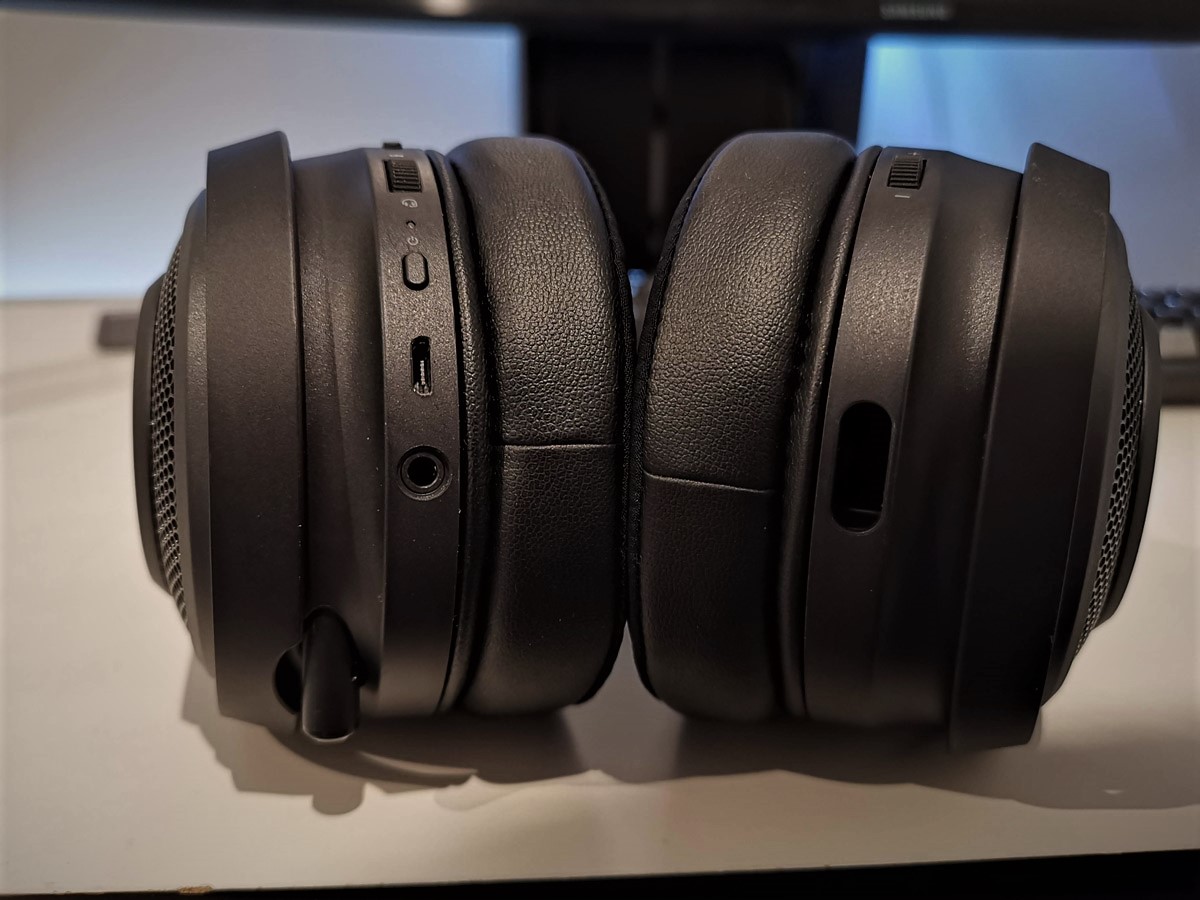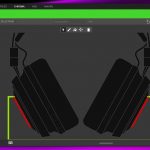When you’re looking for a gaming headset, you have a plethora of options to choose from. Razer’s latest gaming headset series, the Razer Nari headset, is a very solid entrant in a very crowded market.
Gamers spend a silly number of hours in front of the monitor(s) and as such they need the right equipment to get the job done. Most modern games are enjoyed with friends, and as such, you don’t want to let your team down by having to take regular breaks because you bought the wrong headset, that means comfort and audio quality are the two biggest features of a gaming headset.

The design of the Razi Nari is immediately recognisable, with the razer logo, illuminated by multi-coloured LED backlight that can be controlled using Razer Chroma software. On top, you’ll find double metal rails that provide structure to the soft foam that allows it to rest comfortably on your head. This band runs down to the earcups that are large and in charge and definitely prioritise sound quality over size.
The all black design (RGB logo excluded) means you get a stealthy, professional look, immediately giving the aspiring eSports player a serious look to their gaming. They say to others, I love gaming, I’m investing in serious equipment, so take me seriously. Even if not about status, but pure aesthetics, the combination of the strong double headband, along with sturdy full earcups is a good look, one that gives you confidence you’re buying a quality product that’ll last for years to come.
An important design attribute is the swiveling earcups, while these make fitment to almost any head comfortable, it also makes it easy to slide into a backpack. While these aren’t compact by any stretch, this small detail makes the difference between them coming along for a ride or not.
In terms of comfort, the earcups are constructed using gel-infused cushions, this means no matter how tense, how high your get blood pressure, the headset stays cool and comfortable.


FEATURES
What’s on offer?
Battery life
With any wireless headphones, you’ll always ask, how many hours of battery life you get before having to recharge them. Given the thought of your headset dying in the middle of battle is enough to induce anxiety, any product that’s worth a damn needs to last a few serious gaming sessions. Thankfully the Razer Nari headphones have a big enough battery to last a seriously long time. If you use your PC for a couple hours of gaming each night, then you’ll get a couple of weeks, out of them.
The quoted figures from Razer are 14-16 hrs with the lighting turned off, or a little less with the lighting effect enabled. Personally I think this is plenty for most people and being wireless gives you the freedom to get up and grab a drink without having to worry about cords. The headset is rated for around 12m of range.
While you will find a battery life indicator in the software (more on this soon), what you can’t do is roll over it for any detail like a percentage or hours/minutes remaining. This would definitely be a sensible improvement in future iterations.
Game/Chat
On the underside of the left earmuff, you’ll find the standard options like power and mute buttons, as well as the micro-USB charge port and 3.5mm jack should you need it. The extra nice dial on this side is a feature you won’t find on many headsets, the ability to shift the percentage of volume from in-game audio, versus chat audio from your friends. Having this available as a hardware analog dial makes so much sense as its something you’ll often need to adjust match to match, as microphone volumes in multi-player lobbies is a often all over the shop. Sure it’s generally available through software controls if you alt-tab out of the game, but who wants to do that. It’s features like this that show that the headphone and gaming peripheral makers at Razer, really are gamers themselves and understand these problems.
Software
Once you have the headset connected to the PC via Wireless USB (USB dongle is in the headset), you’ll want to grab the Razer Synapse 3.3 software. This software enables you to refine your Razer product and make it your own. This means when you jump into the mixer tab, you get to create a profile that enables THX spatial audio, allowing you to choose, per application if you want Stereo or Surround sound output. Head to the Enhancement tab and you’ll options to control the level of Bass Boost, Sound Normalization and Voice Clarity. Each slider ranges from 10 – 100, I guess you’d struggle to hear the difference under 10% and if you don’t want any of these options, you can disable them.
Next up is the EQ tab which as the name suggests allows you to change the equalisation of the sound being pumped into your ears. There’s some quick and easy presets like Default, Game, Movie, Music but if you’re an audio nerd, then jump into Custom and set it exactly to your liking.
When it comes to Microphone options, I particularly like the ability to add Ambient Noise Reduction, but not just enable/disable, instead we get a slider to fine tune it. Again, nice work Razer, this control allows users to always feel in control.
Lighting
To control the RGB lights behind the Razer logo on each earcup, you head to the Lighting tab of the software. If you want to simply pick your favourite colour, you can absolutely do that, but jump into advanced effects and you’ll have the option for ‘Chrome Studio’. This interface allows you to define colours for any Chroma enabled devices – Razer have keyboards, mice, charging mats and a range of peripherals that support this standard. This means if you’re team Blue, team Red or simply want to distract your opposition at a LAN party, then you can setup a lighting scheme that spands your whole desk.
Thanks to a cool integration with Phillips Hue lights, you could also light the room around you, having the Hue lights sync with your Razer colours. While I wish they’d add full IFTTT integration, Hue is a pretty great starting point.
Technical Specs
We know you guys and girls like details, so here’s the technical specs for the Razer Nari Headset.
- Frequency response: 20 Hz – 20 kHz
- Impedance: 32Ω at 1 kHz
- Sensitivity (@1 kHz): 107 ± 3 dB
- Input power: 30 mW (Max)
- Drivers: 50 mm, with Neodymium magnets
- Inner ear cup diameter: Width 56mm / Length 67mm
- Oval ear cushions: Designed for full-ear coverage with cooling gel, perfect for long-wearing comfort
- Connection type: Wireless USB Transceiver / 3.5mm analog
- Wireless range: 12 m / 40 ft
- Wireless frequency: 2.4 GHz
- Analog connection: 4 – pole
- Battery life: Up to 14 hours with Razer Chroma lighting / 24 hours without Razer Chroma lighting
As for the Microphone, it features the following:
- Frequency response: 100 – 6.5 kHz
- Signal-to-noise ratio: > 50 dB
- Sensitivity (@1 kHz): -42 ± 3 dB
- Pick-up pattern: Unidirectional


Being comfortable to wear meant that testing the audio quality (for many hours) across a wide range of applications (games, music, movies, podcasts etc) was a really enjoyable experience. After experimenting with options available in the software, I settled on a configuration I liked.
I’ve used dozens of headphones over the years and what Razer have achieve in terms of Audio quality is definitely among the best. Thanks to the full coverage of over-the-ear earcups, you’re enveloped in the audio experience and I found myself more immersed in the task at hand than usual. In the case of music, I found I heard more of the audio spectrum than usual.


PRICE & AVAILABILITY
How much and when can you get one ?
The Razer Nari Headphones come in 3 models. The top of the range is the Razer Nari Ultimate which will cost you A$349.95. Next in line is the Razer Nari which retails for A$249.95 and finally the Razer Nari Essential for A$169.95.
The Razer Nari series is available now from RazerStore, or from select electronics retailers. For more information, head to the links below.
- Razer Nari Ultimate: https://www.razer.com/gaming-audio/razer–nari-ultimate
- Razer Nari: https://www.razer.com/gaming-audio/razer–nari
- Razer Nari Essential: https://www.razer.com/gaming-audio/razer–nari-essential


OVERALL
Final thoughts
Razer’s pitch is that their products are made for gamers, by gamers and that’s certainly a statement that rings true in products like the Nari. While I wish I could use the Nari headset for all my audio needs, they don’t work with my phone or Xbox (USB-C phone and I refuse to live a dongle life). They’re certainly on the larger side so that won’t fit all applications (I don’t see anyone wearing these at the gym), so think of these as not an all-round headset, but one that’s seriously great at the target market they’re after.. that being gamers.
If you’re at home and gaming online with friends, controlling the colour of a logo you can’t see on your earcups won’t interest you, but that Phillips Hue integration should. Having the ability for your room to react (lighting) to the game you’re playing, is a very cool concept and if you already have Hue lightstrips under your desk, that may be the killer feature to win you over.
Personally I think the Nari represents great value for money, offering great audio quality, even if the range of applications for the headset isn’t an extensive list. If you’re upgrading to your next gaming headset, then definitely consider the Razer Nari as your next upgrade.











